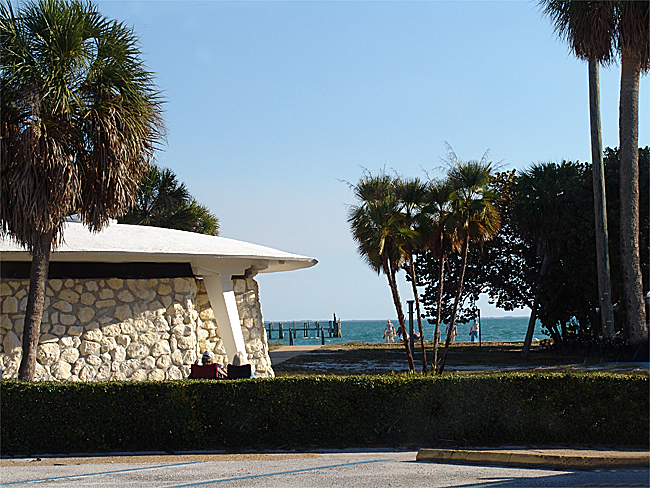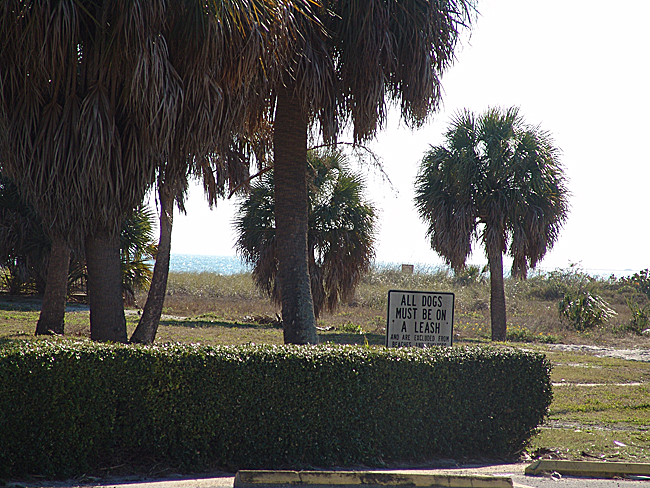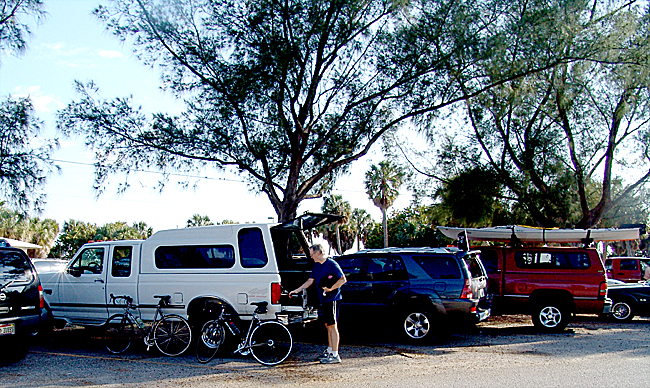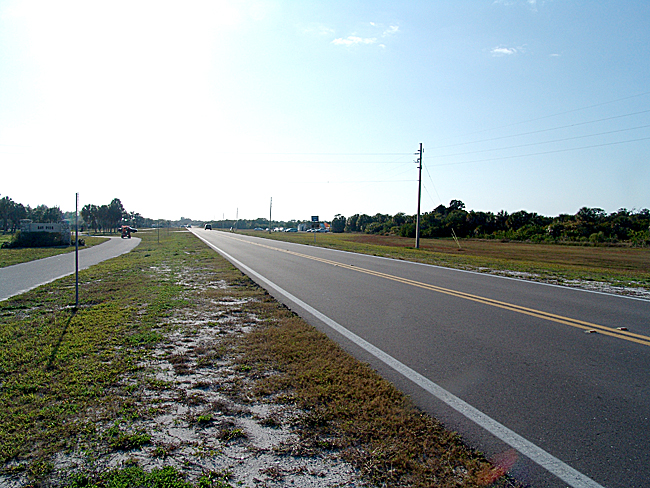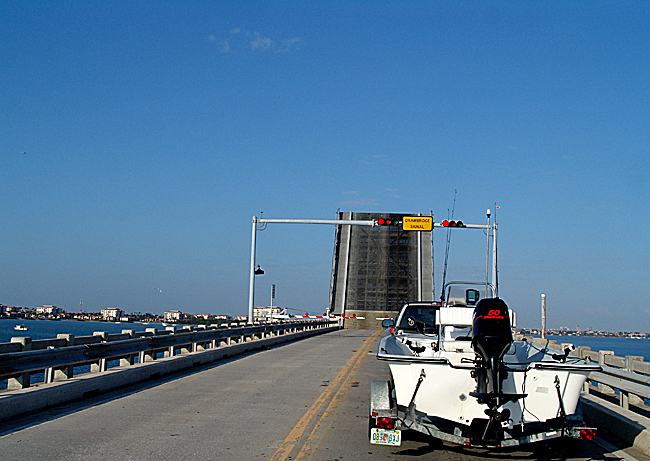|
[
Hump
|
Timeline |
Clearwater Bridge |
Suncoast Trail |
Fort De Soto Park |
Pinellas Trail |
Watts Compared
]
Fort De Soto Park, FL 01/30/08: Today we plan a series of 10:26.08 intervals at 125 watts to test the Widder's Hump split length and confirm a baseline wattage. Mary will use everything she learned yesterday while doing the spin smoothing exercises on the Suncoast Trail, plus we will add a standing exercise every minute to get her in the habit of regular position changes, and to see if doing so helps alleviate the sciatic symptoms. Those symptoms are currently a recurring tingling and weakness in her left foot and ankle. She assures me she has done a lot of web research and has concluded that it is sciatica despite my pointing out the term sciatica is used like people calling a cold the flu. The Widder just calls me Mr. Doom and Gloom when I mention possible neuropathy, etc. I still think she should talk to Dr. Art about it, but... oh, that's right. He ain't here. I have expanded the chart below from yesterday (when we thought 180 was going to work), so the figures above the top gray line are probably even less reliable than those between the two lines. They are merely an extension of the questionable extrapolation of the 180 and 200 watt calculations from yesterday.
Now that I look at the new calculations, I see they are patently absurd. The logarithmic curve for the descending influence of wind resistance is certainly more variable than I have guessed at. Our experience of the 80 watts (just below our warm-up effort) would put the speed closer to 14 mph range. My fudged rate of differential change guesstimate is obviously a farce. I'll have to find an actual formula online. I hadn't anticipated we would have to be looking at wattages this far below the 220 given on the original chart. Fuck me. ---------------------------------- Results: Well, just as I predicted, we confirmed that my guesstimate calculations above are totally bogus. We set out to do 10 min intervals at 125 watts, but Mary felt so good after the first one we never stopped and did our entire standard loop (gate to 40 mph sign after bridge) without a break. Mary kept very close to the goal watts, and we finished just under 17 avg, far from the 18.93 projected by my calculations. Guess I have to track down that formula. In any case, Mary's time was 59:03.7 for our standard loop, which is thus a personal best time, because we have never timed it before. Next time we will try 150 watts. We are moving her momentary standing breaks to 3 minute intervals, because 1 minute is way too quick, and even 2 minutes is a little too often. She even did a few without pedaling but standing on her right foot only in order to relieve pressure from her left. After the ride Mary reports she feels like she didn't even ride, so we are now labeling 125 watt rides, recovery rides. That's our first long period baseline. Finally, we've got a handle on it. We should also do a truck mileage check from the gate to speed limit sign in order to conform our developing process more closely to our Hump split calculations. We want to move up to 10:30 intervals at some percentage above the wattage goal for Widder's Hump. This is fun. 01/31/08: Today, Mary is excited to try 150 watts, so we will repeat yesterday's loop with 25 more watts. Comparison of timed loop with Polar vs. Excel averaging will be interesting. ---------------------------------- Mary was very successful with today's 150 watt loop. There was slightly less wind than yesterday, but coming from the same general south easterly direction. We knew it was lighter after the turn around for the warm-up on the trail. Yesterday, our speed dropped from 18 to 10 mph after the turn, today it was 16 to 12. We extended Mary's standing rests to 3 minute intervals, and she reported her feet were fine with only a slight tingling. Currently her resting stands consist of 5 strong strides, then standing on her right foot (no pedaling) while giving her left foot a full rest. She is getting really good at going straight back to her goal wattage (through feeling it first, then checking her meter second) without overworking by trying to charge back up to wattage thus overcompensating. She did her own tests to confirm that she can indeed feel the watts quicker than the watt meter reports them to her, and she has begun making anticipatory adjustments based on wind load and terrain shifts. More and more often we shift gears in tandem based on the slightest uphill or wind gust. Pretty fucking exciting. She reported feeling almost exactly the same after the ride as yesterday, which was, "...like I didn't even ride." After the ride we drove the truck over the course to confirm it's odometer against my Polar trip computer. The truck showed 16.7 miles, as apposed to our computers which show 16.5 for the test section. Tomorrow is a rest day, then Mary wants to try again at 160. There is something happening logarithmically as the speed into the the air comes down which is not accounted for adequately in my guesstimate calculations based on published figures. To fine tune our calculations I ordered some books in hopes of finding the basic formula that all the bits and pieces of internet discussion regarding watts/mph are based on, but it looks like we will already have our own empirical dataset before we get a solid authoritative reference. People sure do like to make a lot of complication out this concept which is really extremely simple. I guess doing so is more conducive to selling only marginally improved equipment than actual information would be. In line with our empirical data (which I combined in a new spreadsheet with our basic reference chart), it still appears that 253 watts will get us just over her 23 mph avg. We will step up 10 watts each attempt on the test course until we find where Mary cracks. I'm guessing it's going to be somewhere around 200. After that we'll go back to shorter intervals based on a 253 watt goal. Things are not going to get really interesting until Mary sees results of our workouts giving her performance specs that are clearly, indisputably impossible right now. We are still working on finding that line of impossibility and defining it within a target range of 20 watts or so. Hope we can get enough of this done before going back to NY, where the overflow of variables could make the full explanation of this process impossible. 02/01/08: Rest Day 02/02/08: Today's goal was to move up to 160 watts and check results against chart above. Mary's standing rests for her foot were to move to 4 minute intervals. ---------------------------------- Very successful 160 watts. No problem at all for a 19.2 avg, or 19.12, or 19.36 depending on which of our authorities we use. We began Mary's standing rests at 4 min intervals, then settled on 5 min plus allowing a little longer for natural breaks such as the turn at the flag, and the bridge coming out of the park. She had no problem keeping her watts up on the downhill of the bridge due to slightly less of a tail wind. That bodes well for the Widder's Hump, though downhills are still going to be one of our major bętes noires. Mary reported not feeling quite like she had no workout at all (as with the 125 and 150 watts), but said it was the easiest 19+ ride of her life. I reminded her how hard our 19+ rides on this course used to be—even as late as last year with me helping to pull. That watt meter is gold. Plus she is much stronger this year, and we haven't even begun the real work. Our experience over the past several years (and my own before), is that the speeds we can hold back in NY on the hills and mountains tracks very well with what we achieve down here on the flat. It appears to be a function of the downhill rests up north evening out the overall demands in effort. However, my own performance generally gets eaten up pretty quickly with the doughnuts up north. After all, there is that little unavoidable issue of power to weight ratio, so after a couple weeks I'm always back to being a fat ass dropped motherfucker. Be that as it may, today Mary's HR settled in around 157, as apposed to 131+ and 144-ish for the 125 and 150 respectively, so we are getting near the breaking point. Due to a steadier wind, she found it easy to hold a steady 164-8 watts for long periods. However, near the end of the return trip back through Tierra Verde she noticed her HR was 163, but extremely comfortable. The high HR was likely due to us catching a female cyclist and smashing her dreams of glory, while we trashed our own watt target. Still, an easy HR of 163, that's a nice thing to hear. With the helter skelter chaos of the standard Hump, that heart rate is very hard for her, though she can go higher. It's hard to say if the 163 HR was natural drift due to aerobic debt catching up late in the test, or if we both totally lost our focus due to coming up on a female cyclist. Take a look at the photos below to get a handle on how far away it is possible to see a target. One skill we had been working on during the ride was deep breathing to bring down HR. About two miles into the ride Mary reported a HR of 151 which would be low but not out of line with our 125 and 150 watt results. As I periodically questioned her after that it was slowly moving up. Sometime near the end of the second 4 mile split her HR spiked from around 154 to 158 while were were heading into the wind. I told her to get in her drops and rest on her handlebars, but to breathe deeply. She reported her rate dropped back down to 157. Of course, getting in the drops would risk compressing her lungs and leg angle, but it would also bring our land speed up and calm her down. It did. We did a few tests and found she was getting about a 1.5 mile an hour benefit from being in the drops. I cautioned her to use deep breathing if her heart went to 158 again, and she reports she was periodically using the technique with success, until she looked down and found it at 163, but comfortable. Since that happened near the end of the test, while we were coming up on a cyclist, and while I was looking at our average thinking, "Fuck, we are going to be over 19 and it's the easiest 19 of our lives," we are without reliable data as to why the 163 happened. The possibility that we lost track of watts in the heat of the ending points to one of our other major bętes noires for the Widder's Hump. It is going to be really hard to ignore all the taunting, cajoling and triggering that is going to accompany Mary's 23+ program once we get back to NY. Success in her quest will be largely a measure of how well she controls her chase urges. But I have already said too much. Tomorrow we are going to jump to the 180-200 watt target which she failed at last week on the Suncoast Trail. Doing 4 similar workouts in a row like this is a necessary evil, but we can't be doing it forever. Time to move on. She believes the 170 would be very doable, so there's no need to spend an extra day on it. Time to start pushing the envelope. Only 57 days left till returning to NY. At least our real world results have confirmed what I already decided about my guesstimate calculations above. Those were way off the mark, but soon we will move back into the 220 plus range, which is the original numbers from the article that have already proven reliable. In a couple days the two new books should get here, and I may find a useful formula in them... not that we really need it now, but I'm just curious. Plus, I need the reference to support an outrageous claim I will be making in the final version of The Widder's Hump. I'll bet the books will support it, but nobody has had the gumption to come right out and say it before. Unless, maybe nobody has noticed it before. Mary got a couple more nice photos of the park. She titled the one of me Domestique. Pisses me off. 02/03/08: 180-200 watts, standing rests now at 5 minute intervals and without coasting to see if Mary can relax enough to get rid of the pins and needles now that she's not so panicked about surging back up to her wattage. Also, we will put her HR monitor timer on in order to get her heart rate average. And don't forget the deep breathing in the drops trick. ---------------------------------- Total fucking catastrophe. Mary missed the point that 200 watts was supposed to be the absolute max, while she should try to stay just over 180. Therefore, she held a pretty steady 196 till she cracked like a dinner crab. Since we were 20.1 at that point, I took over and pulled, giving her several breaks. She reported that each time I took over, she spiked over 300 watts to catch back on, but then could hold on with mostly 125 watts but dipping to 80 and peaking around 180. That means she got in about 5 hard short intervals, and we ended with a 20.2 avg according to the Polar computers. However, we didn't get an actual time, because at the beginning the sun was in my eyes and I fudged starting the timer. Mary did the same thing for basically the same reason. Had a good time though. 02/04/08: The original thought was to return to intervals and sprints on Gulf Boulevard for awhile, but I couldn't shake the feeling that we should confirm 170 watts was doable before risking overloading Mary's General Adaptation Syndrome (GAS) capacity. We returned to the original idea of standing rests every 4 minutes and once again coasting instead of pedaling at a slow cadence. Mary doesn't seem to be able to rest without a full stop. She interprets any movement as requiring work. Despite the standing rests we finished with a 19.6 avg per the Polar distance and reading, or 19.8 if we use the truck's odometer mileage plus the actual time pasted into my time and mileage calculation spreadsheet. My prediction was 19.6 to 19.9, so the calculations are starting to be useful. During the test Mary started stabbing with her right leg, so I asked her about her HR which she said was at that moment 163. I told her to get in the drops, practice breathing out, relax, and pull through with the right leg. She reported her wattage stabilized and her HR went back down to 159. That was at about the 6 mile mark. I caught a couple such instances and corrected her performance. On the cool down I got her to finally admit her right glute had been bothering her. She finished strong, in fact stronger than necessary. At the final turn-around we had a 20.1 avg, and after I told her it was hard to get her to back off the watts and stay within our target zone. I couldn't stop her from spiking her HR to 165 on the bridge just before the finish. Almost forgot, there was also a school bus dropping off a kid in Tierra Verde, and that caused a significant break in our pace while the kid's mother chatted with the driver. Thanks, lady, for thinking your future carbon footprint hog of accidental protoplasmic offspring is more important than our data. In any case, during the breaks we never tick the watts up over the target zone trying to recapture lost time. Mary's job is to just immediately feel the correct pressure in her legs and allow the inertia to be overcome accordingly. Maybe fewer watts will be needed than we expected, but it's hard to verify if Mary looses her focus and spikes watts. I can usually feel it happen, but I also have a tendency to want that higher avg myself so can also lose focus and let it go. I'm a bad boy. 02/05/08: Rest day, no cycling at all. We were going over stats and talking about the figures given in the two new books when I got up from the couch to get some coffee and noticed Mary's quad was at just that right angle in the light. I yelled, "Don't move a muscle. Don't move. Don't move." She's getting really good at following performance requests, so I finally managed to get a photo of her growing strength without her moving away from the shot with me trying to explain afterward, "No, really it looked better than this. The camera doesn't show it. Plus you moved." She loaded the photo onto the computer and said, "You've got to publish this." And I said, "It will be a lot of fun to hear everybody assume it was Photoshopped." She said, "What?" I reminded her of what she's been doing to people with her Photoshopping escapades. Heh, heh. Here's the photo. 02/06/08: We couldn't resist slimming the envelope prior to pushing it, so we went back to Fort De Soto for one more test on the 16.5 course (see map below), plus filling in some data with regard to the Watts vs. Speed problem. Two days ago, Mary mentioned that 196 watts seemed very comfortable and was just the right amount of pressure for her to hold in a steady state without wide wattage swings. The goal was to see if she could hold that wattage for 4 intervals of 10 min 30 secs, if full recovery was allowed between intervals. That is the time that will be required for her splits in the Widder's Hump, but with less wattage than her goal of 23+. Last week she held a 200 watt performance for a little over 14 minutes on this course, so 196 with shorter intervals seemed worth a try. She had great results, and the test was grueling. I spent a lot of time behind her thinking, "Shit. If I feel like this, what must she be going through?" The first 10:30 was excellent, the 2nd was accomplished but with a few rough spots, and on the third interval she had a pace break at 5 minutes but recovered to resume 196 watts. Unfortunately, the offset due to the full rest recoveries (spinning 80-90 watts until her HR dropped below 120), caused us to run out of road before the completion of the third section. We made it to the turnaround in Tierre Verde, but after that Mary decided she'd had enough. We dropped to 180 watts, and I came up beside her to help pace the last few miles. While doing that I showed her that I could maintain an even wattage due to all the HR training I've done in the past. I said, "Let me know when your watts are 180, and I'll ride beside you and hold the pace for you." That worked out perfectly. Just before the bridge back into the park, I told her to hand me her watt meter then spin as easy as she wanted to the bridge in order to test her maximum watts on the bridge. I said it would probably not be much over 300 due to her toasted state, but she managed a 539 which is 8 watts below her Computrainer record. That is an exceptional result, because Computrainer watts are easier to max. She doesn't have to worry about balance and the stationary bike allows slightly easier leveraging when pulling up on the handle bars. The mph averages versus time, distance and my HR were instructive: warmup: 80-90 watts,
15:19.3 BF HR 100/110, 3.7 miles, 17.4 mph max, 14.8 avg, Wind was south southeast, and not the strongest it has been, but the angle was more southerly than the last several attempts. The warmup avg was typcial, but the difference between max and low was less, because it was more of a side wind. The first interval variance from max to avg (29.5/20.3) speed reflects the tail wind going to the North Beach then the return into the wind, but less time was spent into the wind, because were about 2 tenths mile short of the turn on completion of the time goal. The second interval shows a lower max (25.9, 20.3 avg) because we were mostly in a side wind, except for after the turn at the East Beach for about a mile of almost direct head wind. Interval 3 shows the effect of an almost full out tail wind, 28.4/24.4. It's really nice to have 196 watts result in 28+ mph. However, WATTS IS WATTS, so the pain is equal to the under 20 speeds back into the wind. You will notice that my own heart rate was highest for the final short interval, because I was pacing beside Mary, helping her stay focused and showing her that watts can be felt... they don't have to be read. I was totally shocked with her massive personal best on the road 539 watt final burst. I really expected her to be too hammered to get over 400. I read her numbers to her as they came up, but almost missed them, because I forgot that I should stay seated. I stood at first and found I couldn't look back and down at the meter, and keep up with her all at the same time. Her standing is getting a lot smoother since we did the specific exercises to help it. We'll do more of that. We did feel that the recovery to 120 HR left us too cooled down, and starts of the next intervals could be improved if we allow only down to 135. In any case, interesting results. I spent the evening scouring the Internet for some formulas to make all this test and review unnecessary, so we can get back to training. Found good stuff at a High School physics website, and the terminology I picked up there led me to an online calculator for uphill cycling wattages. Pretty much confirmed what I had been telling Mary that I figured my watts on the Clearwater Bridge must be. 02/07/08: Active recovery day, 30 miles on the Pinellas Trail. Slow standing for smooth balance on the bridges while keeping in mind what the 539 watts felt like yesterday. Also, spin cadence exercises which began with 105 rpm difficult and 120 impossible. By the end of the exercises Mary could spin up to 142 rpm with ease. Discussed how these exercises are like learning a music instrument: slow practice of sections, then sections played for smoothness, then bringing phrases up to speed, and finally an entire piece. She got it. Then we did some shake ups. No you haven't heard of them before, because I thought of them myself. You decide on a wattage, get the feeling of it in your head, then try to match it, but don't check the meter display until you think you've nailed it. Adjust and try again. The original idea was to get her used to 230 watt efforts but at a very short interval of maybe 10 seconds. She was having trouble finding 230 watts. Sometimes way below, sometimes way over. So I had her drop back and practice with watts we've been doing a lot of. Her persistent misconception is that watts have to be built up and that she can stand and regain them if they slip down. She continues to believe that she can grind and grind in order to finally achieve them and that there's a strong direct correlation between watts, inertia, and miles per hour. We need more discussions about the ideas of "at the moment," "momentary concerns," and "momentum" and why similarity in these terms exist. Otherwise, now Mary has an overview of all the elements we'll be working on: sprint, tempo, pace, cadence, intervals being combined into splits, technical standing and seated exercises with precision position and correct movement plus attention to leverage points, etc. In any case, things are coming along very well. The watts issue is pretty much resolving itself as we have established our own empirical data which still implies 230 continuous watts is a good target goal. One of the books even has a minimum of three different values for 20 mph, all at distinct loggerheads. I'm glad the first resource I looked at put us in the 230 range, because one of the figures set 20 mph at 160 watts. We would have definitely been working too low. This watts thing is as if people went into a gym, said they wanted to learn about weight lifting, and were told, "Start with that barbell over there. We can't tell you exactly how much it weighs, but don't worry. It will be different every time you come into the gym anyway. You'll just have to trust us when we tell you who can lift it, and who is best at lifting it. By the way, we have some special lifting gloves that will make all these weights seem feather light. Of course, they are very expensive, but they are worth it. Too bad you can't afford them. That guy over there uses them, and he lifts all these weights with them. Trust us." Ironically, the above scenario would be quite acceptable for a lot of people. Given that our own results are certainly proving useful, they are as valid as the published figures that were developed before the correct tools were available. We are on our way. Next: Return to intervals and sprints. On coming back to the longer tests in Fort De Soto, continue Mary's 4 minute periodic standing rests. Tomorrow we are going to do a relatively light ride up to the Clearwater Bridge. I'm down 5 pounds, so I'll see if I'm getting closer to staying with her 300 watts to the top. Found an online calculator that shows my own watts for that climb is closer to 465. We'll check her max on the bridge return loop (she had a personal best of 539 in Fort De Soto couple days ago), and then some 5 minute 200+ intervals which we will later combine into 10 minute pace intervals, then roll it all back into a 180 watt attempt on the 16.5 mile Fort De Soto test course. But not for awhile. We are officially burnt out on that ride. 02/24/08: Total catastrophe 16 mile test. Goal wattage was 180. Had two total-rest days in preparation after interval, spin, pace work prior. BF watched weather and decided to go out a little early to miss possible afternoon rain. ME had nervous bowel movements numerous times just like pre-Hump. On leaving house BF asked ME if she had all her stuff. Positive. Mary drove to Fort De Soto during discussions of day's plan. Just as BF began to slide out of truck with high hopes ME says, "What? I didn't bring my bag?" ME drove home and picked up her helmet, shorts, shoes, etc then drove back. On the drive back BF said, "You know, this means you will not be able to do 180 watts, no way." ME said, "I want to try." Warmup seemed ok, but after 5.5 miles (16:04) BF said, "You've lost it right?" ME agreed and clicked PowerTap interval, then BF pulled the remainder bringing average from 20.4 up to 20.49 by end according to PowerTap. No HR for BF, because he clicked off his Polar timer when ME stopped trial. Hormones seemed to be a major factor, along with a recurring inability of ME to understand the need to simplify all her routines. The odd circumstance with a dual use back door key, and juggling of exactly what type of music to leave the dog listening to, diverted her attention away from bringing her bag. Oh yeah, the last 2 miles of the test was through the rain due to the 3 hour double drive to park pushing the trial into late afternoon. BF also had not reset his average after the warmup, so when he began pulling he saw only 16.3 and figured he'd just try to bring it up over 18 for fun. If he had known they were so close to 21 he would have pushed the pace to get over it... it's in his nature. His own computer was showing 18.6 toward the end (well over the 18 goal), and he thought, "What good is a 19 going to do me?" When the rain began in earnest he slowed. It's in his nature. 02/25/08: Total redemption 16 mile test. Goal wattage was 180, Mary brought all her stuff, and BF drove in order for her to avoid stressing her right leg which is a recurring drive time problem. During the warmup BF commented, "How do you feel? Feet ok? Right leg ok? You look like the Metal Man today." This time we remembered to implement the standing rests every 4 minutes, but we forgot that the "prepare to stand" warning was for ME to click up to a high gear and then hit 5 to 10 hard standing strides before resting in order to maintain pace. This time Mary bested her previous best length of time at this intensity with a 35:07 perceived 180 watts. The wattage measured was 161 which includes 8 x 4 minute standing rest intervals plus .5 miles after failure before stopping interval at a distance of 11:58 miles, just short of the planned 3rd Hump split distance which would be the top of Ridgebury. This Ridgebury phenomenon has been observed in previous years due to ad hoc training to fail during Hump at Ridgebury. Review of the non-smoothed PowerAgent graph shows that Mary's wattage was in fact very close to 180 for the full 11 miles till failure. In fact, she was trying to be very conservative in not going too far over 180. Our average was 19.79 at the moment of calling it a failure, and that also includes the resting stages which were extra slow, because we forgot that the preparation to stand warning was meant to initiate gear changes up and then 5 to 10 hard standing strokes in order to bring pace up to compensate for the standing slowdown. However, Mary still did not understand that "Watts do not have inertia" and she thought standing and pushing hard would bring her watts back up. In fact that little move served only to push her over the edge and end the interval. We had more discussions about how pace has inertia but wattage is momentary, as in the term momentum, and at the moment. She did thank me at the end for catching one of her form breaks and telling her to focus on her knees when they were all over the place. At the time I mentioned it she said, "I know, but I'm tired." And I replied, "When you are tired is the exact moment you should work on form. Focus on your knees. Just focus on your knees." Afterward she reported doing that caused her wattage to come back up and stabilize. How could you explain that to somebody without them having a watt meter to confirm how it helped? Mary picked the average up to 19.9 for the interval after failure, and that includes the turn around in Tierra Verde, then a slight wind assist plus extra wattage over the bridge at the end. Very good results over all. The 180 interval (161 measured due to breaks) giving us a 19.7 mph/avg tracks almost exactly with the simplified chart which has more optimistic speed/watts figures than our other sources, so we are still very much on track. There is some confusion over the reliability of the PowerTap HR monitor. It appears to have drop-outs and is not as consistent as the Polar monitor.
01/30/08: 125
watts 16.8 avg (per Excel: 16.77) / Polar: 59:03.7 / 16.5 m / BF avg HR
119 max 132 For tests below see PowerAgent PowerTap files for specific interval measurements 02/24/08: After test failure
at 5.46 miles @16:04 BF pulled; per ME timer began early giving 16.7 mi
total 02/25/08: 180 watts 19.7 avg
(per Excel: 19.68)/ Polar: 50:18.6 / 16.5 / BF avg HR 133 max 144
this page last updated:
02/01/2015 10:39:06 PM |
||||||||||||||||||||||||||||||||||||||||||||||||||||||||||||||||

